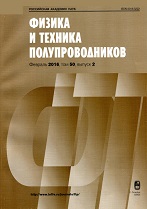|
|
Fizika i Tekhnika Poluprovodnikov, 2018, Volume 52, Issue 5, Page 506
(Mi phts5832)
|
 |
|
 |
This article is cited in 11 scientific papers (total in 11 papers)
XXV International Symposium ''Nanostructures: Physics and Technology'', Saint Petersburg, June 26-30, 2017
Nanostructure Characterization
Composition and band structure of the native oxide nanolayer on the ion beam treated surface of the GaAs wafer
V. M. Mikushkina, V. V. Bryzgalova, S. Yu. Nikonova, A. P. Solonitsynaa, D. E. Marchenkobc
a Ioffe Institute, 194021 St. Petersburg, Russia
b Helmholtz-Zentrum BESSY II, German-Russian Laboratory, D-12489 Berlin, Germany
c Technische Universität Dresden, D-01062 Dresden, Germany
Abstract:
Detailed information on GaAs oxide properties is important for solving the problem of passivating and dielectric layers in the GaAs-based electronics. The elemental and chemical compositions of the native oxide layer grown on the atomically clean surface of an $n$-GaAs (100) wafer etched by Ar$^+$ ions have been studied by synchrotron-based photoelectron spectroscopy. It has been revealed that the oxide layer is essentially enriched in the Ga$_2$O$_3$ phase which is known to be a quite good dielectric as compared to As$_2$O$_3$. The gallium to arsenic ratio reaches the value as high as [Ga]/[As] = 1.5 in the course of oxidation. The Ga-enrichment occurs supposedly due to diffusion away of As released in preferential oxidation of Ga atoms. A band diagram was constructed for the native oxide nanolayer on the $n$-GaAs wafer. It has been shown that this natural nanostructure has features of a $p$–$n$ heterojunction.
Citation:
V. M. Mikushkin, V. V. Bryzgalov, S. Yu. Nikonov, A. P. Solonitsyna, D. E. Marchenko, “Composition and band structure of the native oxide nanolayer on the ion beam treated surface of the GaAs wafer”, Fizika i Tekhnika Poluprovodnikov, 52:5 (2018), 506; Semiconductors, 52:5 (2018), 593–596
Linking options:
https://www.mathnet.ru/eng/phts5832 https://www.mathnet.ru/eng/phts/v52/i5/p506
|


| Statistics & downloads: |
| Abstract page: | 65 | | Full-text PDF : | 14 |
|





 Contact us:
Contact us: Terms of Use
Terms of Use
 Registration to the website
Registration to the website Logotypes
Logotypes








 Citation in format
Citation in format 
